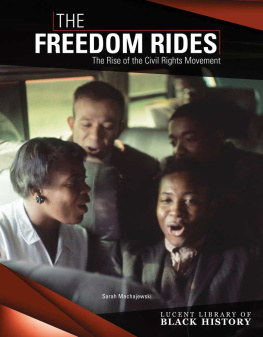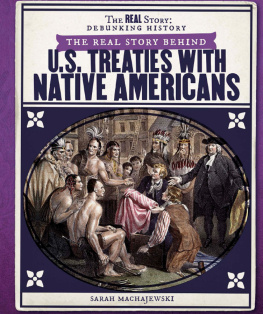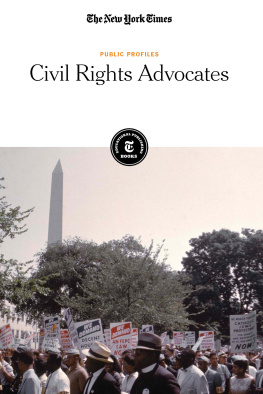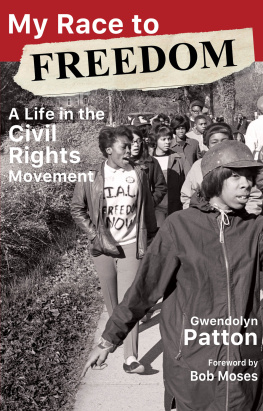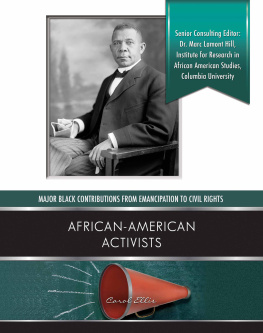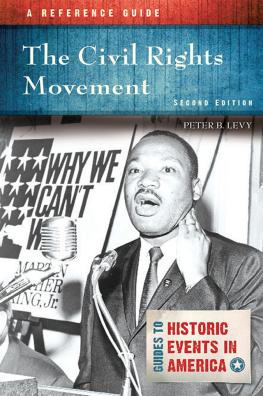Published in 2018 by
Lucent Press, an Imprint of Greenhaven Publishing, LLC
353 3rd Avenue Suite 255
New York, NY 10010
Copyright 2018 Greenhaven Press, a part of Gale, Cengage Learning
Gale and Greenhaven Press are registered trademarks used herein under license.
All new materials copyright 2018 Lucent Press, an Imprint of Greenhaven Publishing, LLC.
All rights reserved. No part of this book may be reproduced in any form without permission in writing from the publisher, except by a reviewer.
Designer: Deanna Paternostro Editor: Nicole Horning
Library of Congress Cataloging-in-Publication Data
Names: Machajewski, Sarah, author.
Title: The freedom rides : the rise of the civil rights movement / Sarah Machajewski.
Description: First edition. | New York : Lucent Press, 2018. | Series: Lucent library of black history | Includes bibliographical references and index.
Identifiers: LCCN 2017038642 | ISBN 9781534562981 (pbk.) | ISBN 9781534562394 (library bound book) | 9781534562400 (ebook)
Subjects: LCSH: Freedom Rides, 1961. | African American civil rights workers-History-20th century. | Civil rights workers-History-20th century. | African Americans-Civil rights-Southern States-History-20th century. | Southern States-Race relations.
Classification: LCC E185.61 .M136 2018 | DDC 323.1196/073-dc23 LC record available at https://lccn.loc.gov/2017038642
Printed in the United States of America
CPSIA compliance information: Batch #CW18KL: For further information contact Greenhaven Publishing LLC, New York, New York at 1-844-317-7404.
Please visit our website, www.greenhavenpublishing.com . For a free color catalog of all our high-quality books, call toll free 1-844-317-7404 or fax 1-844-317-7405.
CONTENTS
CHAPTER ONE :
A Racist Society
CHAPTER TWO :
The First Steps Toward a Full-Blown Movement
CHAPTER THREE :
A Bumpy Road to Equality
CHAPTER FOUR :
The Journey Begins Again
CHAPTER FIVE :
Locked Up
CHAPTER SIX :
Laying a Foundation for the Future
FOREWORD
B lack men and women in the United States have become successful in every field, but they have faced incredible challenges while striving for that success. They have overcome racial barriers, violent prejudice, and hostility on every side, all while continuing to advance technology, literature, the arts, and much more.
From medicine and law to sports and literature, African Americans have come to excel in every industry. However, the story of African Americans has often been one of prejudice and persecution. More than 300 years ago, Africans were taken in chains from their home and enslaved to work for the earliest American settlers. They suffered for more than two centuries under the brutal oppression of their owners, until the outbreak of the American Civil War in 1861. After the dust settled four years later and thousands of Americansboth black and whitehad died in combat, slavery in the United States had been legally abolished. By the turn of the 20th century, with the help of the 13th, 14th, and 15th Amendments to the U.S. Constitution, African American men had finally won significant battles for the basic rights of citizenship. Then, with the passage of the groundbreaking Civil Rights Act of 1964, many people of all races began to believe that America was finally ready to start moving toward a more equal future.
These triumphs of human equality were achieved with help from brave social activists such as Frederick Douglass, Martin Luther King Jr., and Maya Angelou. They all experienced racial prejudice in their lifetimes and fought by writing, speaking, and peacefully acting against it. By exposing the suffering of the black community, they brought the United States together to try and remedy centuries worth of wrongdoing. Today, it is important to learn about the history of African Americans and their experiences in modern America in order to work toward healing the divide that still exists in the United States. This series aims to give readers a deeper appreciation for and understanding of a part of the American story that is often left untold.
Even before the legal emancipation of slaves, black culture was thriving despite many attempts to suppress it. From the 1600s to the 1800s, slaves developed their own cultural perspective. From music, to language, to art, slaves began cultivating an identity that was completely unique. Soon after these slaves were granted citizenship and were integrated into American society, African American culture burst into the mainstream. New generations of authors, scholars, painters, and singers were born, and they spread an appreciation for black culture across America and the entire world. Studying the contributions of these talented individuals fosters a sense of optimism. Despite the cruel treatment and racist attitudes they faced, these men and women never gave up, changing the world with their determination and unique voice. Discovering the triumphs and tragedies of the oppressed allows readers to gain a clearer picture of American history and American cultural identity.
Here to help young readers with this discovery, this series offers a glimpse into the lives and accomplishments of some of the most important and influential African Americans across historical time periods. Titles examine primary source documents and quotes from contemporary thinkers and observers to provide a full and nuanced learning experience for readers. With thoroughly researched text, unique sidebars, and a carefully selected bibliography for further research, this series is an invaluable resource for young scholars. Moreover, it does not shy away from reconciling the brutality of the past with a sense of hopefulness for the future. This series provides critical tools for understanding more about how black history is a vital part of American history.
INTRODUCTION
RISKING LIFE FOR THE RIGHT TO BE EQUAL
R acism and inequality persisted in the American South long after slavery was abolished, and one did not have to look hard to find it. It was on display on every bus and in every bus station. It appeared on public streets and inside schools. It was woven into the fabric of daily life in the South. In 1961, 13 men and women set out from Washington, D.C., to challenge the segregation, or the separation of the races, that occurred in public transportation.
Throughout the southern United States, blacks were required to sit in the back of buses or stand in the aisle. They were also required to use separate restaurants and restroom facilities in bus stations. In 1946 and 1960, the U.S. Supreme Court, in the cases of Morgan v. Virginiaand Boynton v. Virginia, ruled that such separation in interstate bus travel was unconstitutional. Despite these rulings, however, southern bus stations and buses refused to comply with the law. Determined to force the federal government to intervene and enforce the law, these 13 individuals, calling themselves Freedom Riders, rode straight into the heart of racist America.
Setting off on May 4, 1961, the riders were prepared for the worst. The first 10 days of their journey were largely uneventful, and the riders encountered only sporadic harassment and violence. That changed on May 14, 1961, outside Anniston, Alabama. When they arrived, they found members of the Ku Klux Klan (KKK) waiting for them. A violent, racist hate group, the Klan members slashed the tires of the bus carrying the riders. A growing mob of whites stopped the bus just outside Anniston. Someone threw a firebomb through the bus window, and the bus immediately filled with thick, black smoke. As the smoke and flames spread inside the bus, the mob barricaded the bus doors, trapping the helpless riders inside. Burn them alive, someone shouted. It was not until the buss gas tank exploded and the crowd backed away that the riders were able to escape.

